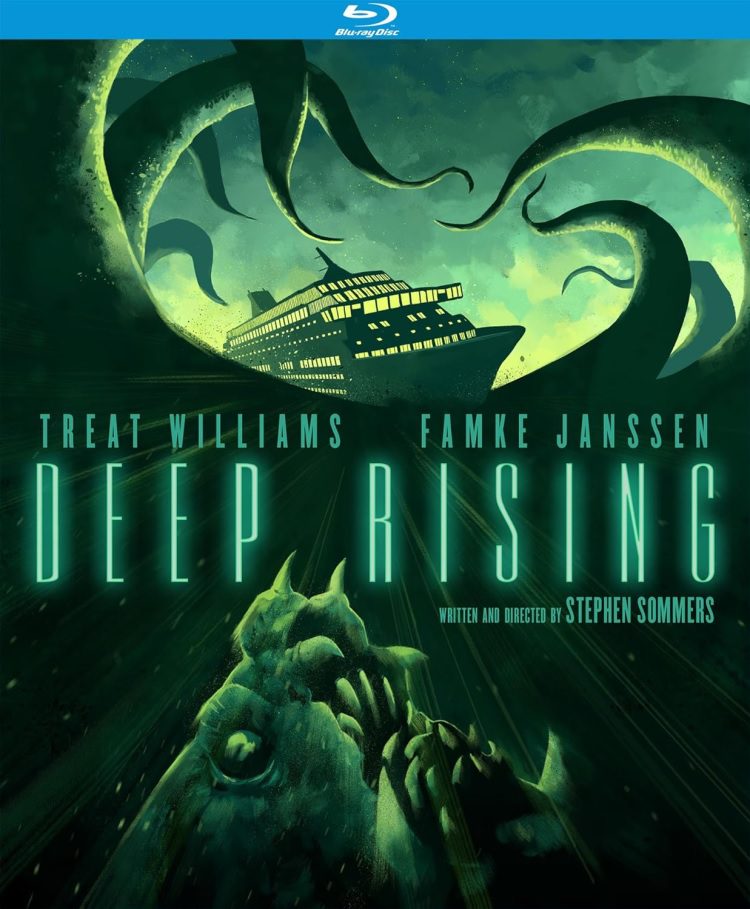
Stephen Sommers’ Deep Rising was one of those movies I wanted to see when it initially released, but I never got around to it until now. I was in seventh grade, and, like most people in that age range, horror movies were something that we rushed out to see. We wanted to see something that was going to make us jump in our seats and entertain us. But, for some reason, I never saw it. It may be because I didn’t hear great things about it and decided to skip. That’s usually what I did and – to some degree – still do when it comes to certain movies.
Now that I have finally seen Deep Rising, I can say that, yes, it certainly is not a good movie. But it is something that you can put on for background noise and just enjoy catching here and there. Or you and a group of friends can get together and make fun of it a la Mystery Science Theater 3000. It’s entertaining, even if it is a bit cheesy, and the special effects don’t hold up at all. Then again, one has to question just how good they were considered back in 1998 when the film was released. That was the same year the first Blade movie came out and, even for that year, the CGI in that wasn’t good. At that time, it was a pivotal moment for movies like Blade and Deep Rising. Both films cost just $45 million to make, but they had the capability to use CGI that seemed like it was only reserved for the $100 million-plus blockbusters. So, while both films didn’t quite have the access others did, they went with what they could. Filmmakers like Sommers were still using practical effects for certain things (e.g., piles of dead bodies), but when it came to big, scary sea creatures, they also had the option to go to the computer for that.
That’s exactly what the monster in Deep Rising is; it’s a big, computer-generated monster that doesn’t look scary in the slightest. On one hand, it looks unfinished and kind of silly. On the other, for how big Sommers and the crew made the creature, and the fact that they had to move it around a big ship, it seems impossible to create strictly from practical effects or combining both practical and non-practical work. So, you have to give them props there.
The interesting thing about Deep Rising is, there are no heroes in the film. Sure, Treat Williams’s character, John Finnegan, kind of becomes heroic as he becomes the leader in stopping the creature and pulling everyone to safety. But, in the beginning, he and his group of mercenaries tried to rob a cruise ship, only to become trapped by the creature that has taken over. Anthony Heald’s character, Simon Canton, is the head of the ship, but he is deceptive in his own way. Famke Janssen’s Trillian was seen stealing stuff from the ship prior to the collision with the monster.
So, in a sense, this is where the viewer is forced to root for the bad guys and only the bad guys. They do have some likable aspects to them. Williams’s performance is similar to how Harrison Ford would have approached the character. He’s smug and likes to take charge, but there is a charm to him. Kevin J. O’Connor is the wacky Joey Pantucci, who is always panicked and says some funny lines here and there. Aside from Williams, the acting isn’t really that special, but it is fun watching these characters bicker at each other and try to escape the ship.
Kino Lorber has done a fine job with releasing a new Blu-ray transfer of Deep Rising. The image is a 2.35:1 aspect ratio with a 1920x1080p presentation. The audio transfer is 5.1 surround and 2.0 stereo, so you can hear Jerry Goldsmith’s entertaining score quite well through the speakers.
There are a ton of interviews for fans of Deep Rising to enjoy, including interviews with cast members West Studi, Kevin J. O’Connor, and Anthony Heald, as well as members in the visual effects and makeup departments. We also get some segments that show the rendering of the visuals and how they look in various stages that is quite interesting to watch. This new collector’s edition also comes with an audio commentary from director Stephen Sommers and editor Bob Ducsay, as well as a new cover that contains commissioned art by Jacob Phillips on one side and the film’s original poster on the other side.
The one downside to this new release is that the closed-captioning did seem a bit off. Some of the characters would say a line, and the dialogue would show up on the screen after it was already said. Sometimes, the movie would have already moved on to the next piece of dialogue, and the captions were playing catch-up. It was a bit frustrating to see that, but if you don’t use closed-captioning, it’s not an issue.
Nowadays, Deep Rising might be the type of film that would be a SyFy Original. It doesn’t have the greatest acting, dialogue, or visual effects, and it’s not going to be considered a classic in film history. But it also doesn’t take itself too seriously. And, in the end, that’s what makes it so fun to watch.